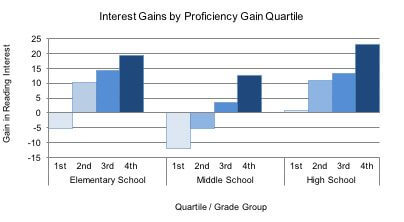
Purpose of Study:
Research has shown that students’ perceptions about themselves as readers can affect not only overall levels of reading effectiveness, but also the extent to which they engage in reading and use reading as a strategic learning tool. Relatedly, students with high intrinsic motivation are likely to read three times as many minutes per day as compared to those with low intrinsic motivation. The resulting differences in reading experience can amount to millions of words over the course of a single year and contribute to an ever-expanding gap in reading proficiency and academic success.
This study examined relationships between reading motivation and proficiency, and growth in these measures, in a large national sample of students who engaged in Reading Plus during the 2015-16 school year.
Study Design:
This study was based on a national sample of 142,223 elementary, middle, and high school students who completed two InSight assessments during the 2015-16 school year, 92% of whom also completed reading practice lessons in Reading Plus. The InSight assessment was used to measure motivation, with a focus on reading interest and confidence, as well as each student’s reading comprehension level, vocabulary level, and silent reading rate. The latter measures were also combined to yield an overall proficiency score (see InSight Technical Brief for more information)
For the analyses, students were divided into four groups in various ways; i.e., comprising those with increasing levels of reading interest, reading confidence, or those who achieved progressively larger gains in reading proficiency.
Key Results:
All analyses pointed to the same conclusion: Reading proficiency and reading motivation develop together.
Across all grade groups, students who reported higher levels of interest and confidence also demonstrated significantly higher levels of reading comprehension and reading efficiency. Further, increases in interest and confidence over the school year were significantly larger in students who increased their reading proficiency to a greater extent.
Students in all grade groups who engaged in at least 100 practice lessons in Reading Plus achieved significantly larger reading proficiency gains than students who did not complete lessons. Further, the amount of proficiency growth achieved by those who completed lessons was similar regardless of their initial levels of interest or confidence in reading. In other words, Reading Plus can help students become more proficient readers even if their reading motivation is low.

